-
 Iron tsuba of round form decorated with eight circular emblems of flowers and/or family crests (mon) made of cast brass, pierced and chiseled in kebori, as well as with flat brass inlay (hira-zōgan) of vines, leaves, and flowers all over the plate. Yoshirō school (Kaga-Yoshirō). The Momoyama or early Edo period, 17th century. Size: diameter 80 mm, thickness at seppa-dai 3,6 mm. Symbols: [12:00 o'clock] - Wood sorrel (katabami) and swords ; [9:00] - Cherry blossom (sakura); [7:30] - Bellflower (kikyō), kamon of Toki clan; [3:00] - possibly, a six-petal Chrysanthemum (kiku) or a Passion flower (tessen); [1:30] - Hemp (asanoha). The symbols at 6:00, 10:30, and 4:30 o'clock seem to be geometrical patterns of auspicious meaning: a cross in a square, a four pointing star, and a diamond, respectively. Alternatively, we may look at this piece as purely decorative, with patterns at 12:00, 3:00, 6:00, and 9:00 o'clock in negative openwork (in-sukashi), and at 1:30, 4:40, 7:20, and 10:30 o'clock - in positive openwork (ji-sukashi, or yō-sukashi). Markus Sesko in his Handbook of sword fittings related terms [Herstellung und Verlag: Books on Demand GmbH, Norderstedt, 2011] discriminates this type of openwork in a separate class: Ranma-sukashi: "This term is applied to circular sukashi with family crests to their inside, which are arranged running along the rim area. The description goes back to the opened boards (ranma) between the sliding doors and the ceiling of Japanese rooms. Ranma-sukashi are mostly seen on old Heianjō- or Yoshirō-zōgan-tsuba but also on works of Hayashi Matashichi" [page 30].
Iron tsuba of round form decorated with eight circular emblems of flowers and/or family crests (mon) made of cast brass, pierced and chiseled in kebori, as well as with flat brass inlay (hira-zōgan) of vines, leaves, and flowers all over the plate. Yoshirō school (Kaga-Yoshirō). The Momoyama or early Edo period, 17th century. Size: diameter 80 mm, thickness at seppa-dai 3,6 mm. Symbols: [12:00 o'clock] - Wood sorrel (katabami) and swords ; [9:00] - Cherry blossom (sakura); [7:30] - Bellflower (kikyō), kamon of Toki clan; [3:00] - possibly, a six-petal Chrysanthemum (kiku) or a Passion flower (tessen); [1:30] - Hemp (asanoha). The symbols at 6:00, 10:30, and 4:30 o'clock seem to be geometrical patterns of auspicious meaning: a cross in a square, a four pointing star, and a diamond, respectively. Alternatively, we may look at this piece as purely decorative, with patterns at 12:00, 3:00, 6:00, and 9:00 o'clock in negative openwork (in-sukashi), and at 1:30, 4:40, 7:20, and 10:30 o'clock - in positive openwork (ji-sukashi, or yō-sukashi). Markus Sesko in his Handbook of sword fittings related terms [Herstellung und Verlag: Books on Demand GmbH, Norderstedt, 2011] discriminates this type of openwork in a separate class: Ranma-sukashi: "This term is applied to circular sukashi with family crests to their inside, which are arranged running along the rim area. The description goes back to the opened boards (ranma) between the sliding doors and the ceiling of Japanese rooms. Ranma-sukashi are mostly seen on old Heianjō- or Yoshirō-zōgan-tsuba but also on works of Hayashi Matashichi" [page 30]. -
 Iron tsuba of round form decorated with eight roundels – circular emblems of flowers and/or family crests (mon) made of cast brass, pierced and chiseled in kebori, and with flat brass inlay (hira-zōgan) of vines or leaves all over the plate. Both hitsu-ana trimmed in brass. Nakago-ana of rectangular form, with copper sekigane. Four positive openwork (ji-sukashi) roundels at 12, 3, 6, and 9 o'clock; and four negative openwork (in-sukashi) roundels with cherry blossom, bellflower, and two variations on suhama theme. Yoshirō school (Kaga-Yoshirō). The Momoyama or early Edo period, late 16th to early 17th century. Size: diameter 81.4 mm, thickness 4.7 mmat seppa-dai, 4.0 mm at rim. Christie's lot description: AN IRON TSUBA; EDO PERIOD (17TH CENTURY). THE DOLPHYN COLLECTION OF SAMURAI ART. The round iron tsuba pierced with roundels of various floral motifs interspersed among scrolling foliage, all inlaid with brass. 8.1 cm. high. Provenance: Pabst Collection (no. 338).
Iron tsuba of round form decorated with eight roundels – circular emblems of flowers and/or family crests (mon) made of cast brass, pierced and chiseled in kebori, and with flat brass inlay (hira-zōgan) of vines or leaves all over the plate. Both hitsu-ana trimmed in brass. Nakago-ana of rectangular form, with copper sekigane. Four positive openwork (ji-sukashi) roundels at 12, 3, 6, and 9 o'clock; and four negative openwork (in-sukashi) roundels with cherry blossom, bellflower, and two variations on suhama theme. Yoshirō school (Kaga-Yoshirō). The Momoyama or early Edo period, late 16th to early 17th century. Size: diameter 81.4 mm, thickness 4.7 mmat seppa-dai, 4.0 mm at rim. Christie's lot description: AN IRON TSUBA; EDO PERIOD (17TH CENTURY). THE DOLPHYN COLLECTION OF SAMURAI ART. The round iron tsuba pierced with roundels of various floral motifs interspersed among scrolling foliage, all inlaid with brass. 8.1 cm. high. Provenance: Pabst Collection (no. 338). -
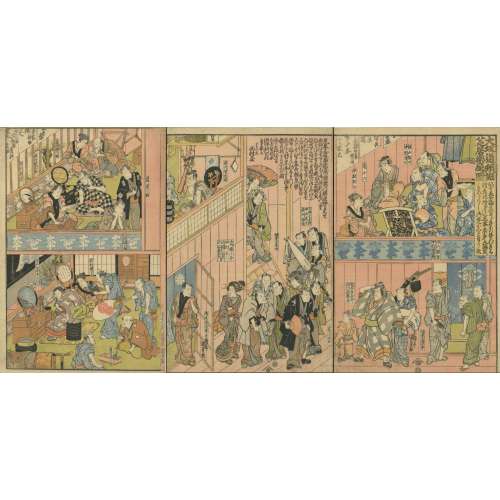 Artist: Utagawa Kunisada [歌川 国貞] a.k.a. Utagawa Toyokuni III [三代歌川豊国] (Japanese, 1786 – 1865). Publisher: Nishimuraya Yohachi [西村屋与八] (Japanese, fl. c. 1751 – 1860), seal name: Eijudō. Date: c. 1821–22 (Bunsei 4–5) Size: Ōban tate-e triptych, each sheet 36.8 x 26.4 cm. Signed: 五渡亭国貞画 – Gototei Kunisada ga (on center sheet). Censor’s seal: kiwame 改印: 極 A view of the dressing room of a Theater in Dōtonbori, Ōsaka (Ōsaka Dōtonbori shibai gakuya no zu): Right sheet: Actors Bandō Mitsuemon I, Asao Tamejūrō III, Ichikawa Danzō V, Nakamura Utaemon III, Bandō Mitsugorō III (in a costume of Matsuômaru), Kiriyama Monji III, Nakamura Utashichi II, Arashi Shôroku IV, Nakamura Matsue III, Matsumoto Kōshirō V, Ichikawa Komazō V. Centre sheet: Arashi Mitsugorō III, Mimasu Daigorō III, Nakayama Bunshichi III, Ichikawa Ichizō II, Bandō Minosuke II, Ichikawa Omezō I, Arashi Kitsusaburō I, Nakamura Utaroku I, Kataoka Nizaemon VII, Ōtani Tomoemon III, Asao Yūjirō I. Left sheet: Asao Kuzaemon I, Arashi Hidenosuke III, Sawamura Gennosuke II, Iwai Ōginosuke, Sawamura Kunitarō II, Iwai Matsunosuke I, Ichikawa Sōzaburō IV, Iwai Hanshirō V (in a costume of Sakuramaru), and Ichikawa Shinzō III (L). The actors are making up for a performance of the “Carriage-Stopping” scene from Sugawara Denju Tenarai Kagami (Sugawara Denju and the Secrets of Calligraphy). References: MFA Accession №: 11.43384a-c; Catalogue Raisonné: Izzard, Kunisada’s World (1993), #34; Hizô Ukiyo-e taikan/Ukiyo-e Masterpieces in European Collections 5, Victoria and Albert Museum II (1987), pl. 22; Keyes, PMA Osaka cat. (1973), #250 and pl. 15 (The theatrical world of Osaka prints, by Roger S. Keyes and Keiko Mizushima, Philadelphia Museum of Art, 1973), pp. 70-71); Izzard, Kunisada's world revisited, 2021; V&A Accession № E.5995-1886. Kabuki actors on this print: Arashi Hidenosuke III [嵐秀之助] (Japanese, fl. 1794 – 1837); other names: Arashi Koshichi IV, Arashi Hinasuke IV, Arashi Sanjūrō VI, Kanō Hidenosuke II, Kanō Umetarō, Arashi Iwajirō III. Arashi Kitsusaburō I [嵐橘三郎] (Japanese, 1769 – 1821); other names: Arashi Kichisaburō II, Arashi Rikan I. Arashi Mitsugorō III (Japanese, ? – ?) Arashi Shōroku IV [四代目嵐小六] (Japanese, 1783 – 1826) Asao Kuzaemon I [浅尾工左衛門] (Japanese, 1758 – 1824); other names: Asai Kuzaemon Nakayama Tashirō II Takeda Nisaburō. Asao Tamejūrō III [三代目淺尾爲十郎] (Japanese, 1780 – 1836); other names: Asao Okuyama III, Asao Okuyama III, Asao Tomozō I. Asao Yūjirō I [浅尾勇次郎] (Japanese, 1782 – 1835); other names: Jitsukawa Gakujūrō I, Asao Gakujūrō, Nakamura Yaozō, Asao Yaozō. Bandō Minosuke II [坂東蓑助] (Japanese, 1802 – 1863); other names: Morita Kan'ya XI, Bandô Mitsugorō IV. Bandō Mitsuemon I [坂東三津右衛門] (Japanese, 1788 – 1846); other names: Bandō Kumahei [坂東熊平]. Bandō Mitsugorō III [三代目 坂東 三津五郎] (Japanese, 1775 – 1831); other names: Bandō Minosuke I, Morita Kanjirô II, Bandō Mitahachi I, Bandō Minosuke I, Bandō Mitahachi I. Ichikawa Danzō V [市川団蔵] (Japanese, 1788 – 1845); other names: Ichikawa Shikō I, Ichikawa Danzaburō IV, Ichikawa Danjirō I, Ichikawa Morinosuke I. Ichikawa Ichizō II [市川市蔵] (Japanese, 1806 – 1829); other names Ichikawa Ebijūrō II, Ichikawa Sukezō I. Ichikawa Komazō V [市川高麗蔵] (Japanese, 1812 – 1849); other names: Matsumoto Kinshō I, Matsumoto Kōshirō VI, Matsumoto Kinshi. Ichikawa Omezō I [市川男女蔵] (Japanese, 1781 – 1833); other names: Ichikawa Benzō II, Ichikawa Bennosuke. Ichikawa Shinzō III [市川新蔵] (Japanese, 1793 – 1837); other names: Ichikawa Sumizō III, Nakayama Tomisaburô II, Nakayama Kinsha, Nakayama Tomisaburō II, Ichikawa Komazō IV, Ichikawa Santarō. Ichikawa Sōzaburō IV (Japanese, ? – ?) Iwai Hanshirō V [岩井半四郎] (Japanese, 1776 – 1847); other names: Iwai Tojaku, Iwai Kumesaburō I. Iwai Matsunosuke I [岩井松之助] (Japanese, 1804 – 1845); other names: Iwai Hanshirō VII, Iwai Shijaku I, Iwai Komurasaki I. Iwai Ōginosuke (Japanese, ? – ?) Kataoka Nizaemon VII [七代目片岡仁左衛門] (Japanese, 1755 – 1837); other names: Yamazawa Kunigorō, Asao Kunigorō II, Nakamura Matsusuke. Kiriyama Monji III [桐山紋治] (Japanese, fl. c. 1803 – 1830); other names: Ichikawa Takigorō. Matsumoto Kōshirō V [五代目松本幸四郎] (Japanese, 1764-1838); other names: Ichikawa Komazô III, Ichikawa Sumizô I. Mimasu Daigorō III [三枡大五郎] (Japanese, 1782 – 1824); other names: Mimasu Seibē, Yoshizawa Kamezō. Nakamura Matsue III [三代目中村松江] (Japanese, 1786-1855); other names: Nakamura Sankō I, Nakamura Tomijūrō II, Ichikawa Kumatarō. Nakamura Utaemon III [中村歌右衛門] (Japanese, 1778 – 1838); other names: Nakamura Tamasuke, Nakamura Baigyoku I, Nakamura Shikan I, Kagaya Fukunosuke I. Nakamura Utaroku I (Japanese, ? – ?) Nakamura Utashichi II (Japanese, ? – ?) Nakayama Bunshichi III [三代目目中山文七] (Japanese, 1764 – 1853); other names: Nakayama Hyakka, Nakayama Hyōtarō I, Nakayama Tokusaburō. Ōtani Tomoemon III [大谷友右衛門] (Japanese, 1793–1839); other names: Arashi Shagan IV, Arashi Sanpachi II, Nakayama Monzaburō. Sawamura Gennosuke II [沢村源之助](Japanese, 1802/7 – 1853); other names: Suketakaya Takasuke III, Sawamura Chōjūrō V, Sawamura Sōjūrō V, Sawamura Tosshō I, Sawamura Genpei I. Sawamura Kunitarō II [沢村国太郎](Japanese, 1798 – 1836); other names: Ogino Kinshi, Ogino Yaegiri III, Ogino Kamekichi, Izumikawa Kamekichi.
Artist: Utagawa Kunisada [歌川 国貞] a.k.a. Utagawa Toyokuni III [三代歌川豊国] (Japanese, 1786 – 1865). Publisher: Nishimuraya Yohachi [西村屋与八] (Japanese, fl. c. 1751 – 1860), seal name: Eijudō. Date: c. 1821–22 (Bunsei 4–5) Size: Ōban tate-e triptych, each sheet 36.8 x 26.4 cm. Signed: 五渡亭国貞画 – Gototei Kunisada ga (on center sheet). Censor’s seal: kiwame 改印: 極 A view of the dressing room of a Theater in Dōtonbori, Ōsaka (Ōsaka Dōtonbori shibai gakuya no zu): Right sheet: Actors Bandō Mitsuemon I, Asao Tamejūrō III, Ichikawa Danzō V, Nakamura Utaemon III, Bandō Mitsugorō III (in a costume of Matsuômaru), Kiriyama Monji III, Nakamura Utashichi II, Arashi Shôroku IV, Nakamura Matsue III, Matsumoto Kōshirō V, Ichikawa Komazō V. Centre sheet: Arashi Mitsugorō III, Mimasu Daigorō III, Nakayama Bunshichi III, Ichikawa Ichizō II, Bandō Minosuke II, Ichikawa Omezō I, Arashi Kitsusaburō I, Nakamura Utaroku I, Kataoka Nizaemon VII, Ōtani Tomoemon III, Asao Yūjirō I. Left sheet: Asao Kuzaemon I, Arashi Hidenosuke III, Sawamura Gennosuke II, Iwai Ōginosuke, Sawamura Kunitarō II, Iwai Matsunosuke I, Ichikawa Sōzaburō IV, Iwai Hanshirō V (in a costume of Sakuramaru), and Ichikawa Shinzō III (L). The actors are making up for a performance of the “Carriage-Stopping” scene from Sugawara Denju Tenarai Kagami (Sugawara Denju and the Secrets of Calligraphy). References: MFA Accession №: 11.43384a-c; Catalogue Raisonné: Izzard, Kunisada’s World (1993), #34; Hizô Ukiyo-e taikan/Ukiyo-e Masterpieces in European Collections 5, Victoria and Albert Museum II (1987), pl. 22; Keyes, PMA Osaka cat. (1973), #250 and pl. 15 (The theatrical world of Osaka prints, by Roger S. Keyes and Keiko Mizushima, Philadelphia Museum of Art, 1973), pp. 70-71); Izzard, Kunisada's world revisited, 2021; V&A Accession № E.5995-1886. Kabuki actors on this print: Arashi Hidenosuke III [嵐秀之助] (Japanese, fl. 1794 – 1837); other names: Arashi Koshichi IV, Arashi Hinasuke IV, Arashi Sanjūrō VI, Kanō Hidenosuke II, Kanō Umetarō, Arashi Iwajirō III. Arashi Kitsusaburō I [嵐橘三郎] (Japanese, 1769 – 1821); other names: Arashi Kichisaburō II, Arashi Rikan I. Arashi Mitsugorō III (Japanese, ? – ?) Arashi Shōroku IV [四代目嵐小六] (Japanese, 1783 – 1826) Asao Kuzaemon I [浅尾工左衛門] (Japanese, 1758 – 1824); other names: Asai Kuzaemon Nakayama Tashirō II Takeda Nisaburō. Asao Tamejūrō III [三代目淺尾爲十郎] (Japanese, 1780 – 1836); other names: Asao Okuyama III, Asao Okuyama III, Asao Tomozō I. Asao Yūjirō I [浅尾勇次郎] (Japanese, 1782 – 1835); other names: Jitsukawa Gakujūrō I, Asao Gakujūrō, Nakamura Yaozō, Asao Yaozō. Bandō Minosuke II [坂東蓑助] (Japanese, 1802 – 1863); other names: Morita Kan'ya XI, Bandô Mitsugorō IV. Bandō Mitsuemon I [坂東三津右衛門] (Japanese, 1788 – 1846); other names: Bandō Kumahei [坂東熊平]. Bandō Mitsugorō III [三代目 坂東 三津五郎] (Japanese, 1775 – 1831); other names: Bandō Minosuke I, Morita Kanjirô II, Bandō Mitahachi I, Bandō Minosuke I, Bandō Mitahachi I. Ichikawa Danzō V [市川団蔵] (Japanese, 1788 – 1845); other names: Ichikawa Shikō I, Ichikawa Danzaburō IV, Ichikawa Danjirō I, Ichikawa Morinosuke I. Ichikawa Ichizō II [市川市蔵] (Japanese, 1806 – 1829); other names Ichikawa Ebijūrō II, Ichikawa Sukezō I. Ichikawa Komazō V [市川高麗蔵] (Japanese, 1812 – 1849); other names: Matsumoto Kinshō I, Matsumoto Kōshirō VI, Matsumoto Kinshi. Ichikawa Omezō I [市川男女蔵] (Japanese, 1781 – 1833); other names: Ichikawa Benzō II, Ichikawa Bennosuke. Ichikawa Shinzō III [市川新蔵] (Japanese, 1793 – 1837); other names: Ichikawa Sumizō III, Nakayama Tomisaburô II, Nakayama Kinsha, Nakayama Tomisaburō II, Ichikawa Komazō IV, Ichikawa Santarō. Ichikawa Sōzaburō IV (Japanese, ? – ?) Iwai Hanshirō V [岩井半四郎] (Japanese, 1776 – 1847); other names: Iwai Tojaku, Iwai Kumesaburō I. Iwai Matsunosuke I [岩井松之助] (Japanese, 1804 – 1845); other names: Iwai Hanshirō VII, Iwai Shijaku I, Iwai Komurasaki I. Iwai Ōginosuke (Japanese, ? – ?) Kataoka Nizaemon VII [七代目片岡仁左衛門] (Japanese, 1755 – 1837); other names: Yamazawa Kunigorō, Asao Kunigorō II, Nakamura Matsusuke. Kiriyama Monji III [桐山紋治] (Japanese, fl. c. 1803 – 1830); other names: Ichikawa Takigorō. Matsumoto Kōshirō V [五代目松本幸四郎] (Japanese, 1764-1838); other names: Ichikawa Komazô III, Ichikawa Sumizô I. Mimasu Daigorō III [三枡大五郎] (Japanese, 1782 – 1824); other names: Mimasu Seibē, Yoshizawa Kamezō. Nakamura Matsue III [三代目中村松江] (Japanese, 1786-1855); other names: Nakamura Sankō I, Nakamura Tomijūrō II, Ichikawa Kumatarō. Nakamura Utaemon III [中村歌右衛門] (Japanese, 1778 – 1838); other names: Nakamura Tamasuke, Nakamura Baigyoku I, Nakamura Shikan I, Kagaya Fukunosuke I. Nakamura Utaroku I (Japanese, ? – ?) Nakamura Utashichi II (Japanese, ? – ?) Nakayama Bunshichi III [三代目目中山文七] (Japanese, 1764 – 1853); other names: Nakayama Hyakka, Nakayama Hyōtarō I, Nakayama Tokusaburō. Ōtani Tomoemon III [大谷友右衛門] (Japanese, 1793–1839); other names: Arashi Shagan IV, Arashi Sanpachi II, Nakayama Monzaburō. Sawamura Gennosuke II [沢村源之助](Japanese, 1802/7 – 1853); other names: Suketakaya Takasuke III, Sawamura Chōjūrō V, Sawamura Sōjūrō V, Sawamura Tosshō I, Sawamura Genpei I. Sawamura Kunitarō II [沢村国太郎](Japanese, 1798 – 1836); other names: Ogino Kinshi, Ogino Yaegiri III, Ogino Kamekichi, Izumikawa Kamekichi. -
 Iron tsuba of round form decorated with design of pine tree mushrooms (matsutake) in openwork (sukashi). Hitsu-ana of elongated oval form. Raised rim (mimi) with iron bones (tekkotsu). Copper sekigane. Size: 84.5 mm x 85.1 mm; thickness: 3.0 mm (center), 5.6 mm (rim). Mid Muromachi period, 15th century. The shape and width of the rim, as well as the shape of the hitsu-ana, argue for earlier Muromachi. Tsuba is slightly wider than high, that might suggest middle of Muromachi age. According to Robert Haynes, circa 1450-1500.
Iron tsuba of round form decorated with design of pine tree mushrooms (matsutake) in openwork (sukashi). Hitsu-ana of elongated oval form. Raised rim (mimi) with iron bones (tekkotsu). Copper sekigane. Size: 84.5 mm x 85.1 mm; thickness: 3.0 mm (center), 5.6 mm (rim). Mid Muromachi period, 15th century. The shape and width of the rim, as well as the shape of the hitsu-ana, argue for earlier Muromachi. Tsuba is slightly wider than high, that might suggest middle of Muromachi age. According to Robert Haynes, circa 1450-1500. -
 Iron tsuba of slightly elongated round form decorated with design of melon flowers, vines, and leaves in brass flat inlay (hira-zōgan) on both sides. Slightly raised rim (mimi) carved in a way to simulate ring-shaped covering (fukurin). Kozuka hitsu-ana and kogai hitsu-ana both plugged with soft metal (tim or lead). Copper sekigane. Heianjō or Kaga School. Muromachi or Momoyama period, 16th century. Iron, hira-zōgan brass inlay. Round (maru gata) form, diameter 79 mm. Size: 80.3 x 78.4 mm; thickness at seppa-dai: 3.4 mm; at the middle: 3.8 mm; before the rim: 2.4 mm, rim: 2.8 mm. Note on design: though this design resembles family crests with oak and mulberry leaves, I believe it's a melon flower [see Jeanne Allen. Designer's guide to Samurai Patterns. Chronicle Books, San Francisco, 1990, page 114, №130 "Melon Flowers":Note about the distribution of thickness (niku-oki): "this tsuba has toroid features, niku raises from the rim towards the centre but thins once more out when approaching the seppa-dai" [M. Sesko, "Handbook...", p. 48].
Iron tsuba of slightly elongated round form decorated with design of melon flowers, vines, and leaves in brass flat inlay (hira-zōgan) on both sides. Slightly raised rim (mimi) carved in a way to simulate ring-shaped covering (fukurin). Kozuka hitsu-ana and kogai hitsu-ana both plugged with soft metal (tim or lead). Copper sekigane. Heianjō or Kaga School. Muromachi or Momoyama period, 16th century. Iron, hira-zōgan brass inlay. Round (maru gata) form, diameter 79 mm. Size: 80.3 x 78.4 mm; thickness at seppa-dai: 3.4 mm; at the middle: 3.8 mm; before the rim: 2.4 mm, rim: 2.8 mm. Note on design: though this design resembles family crests with oak and mulberry leaves, I believe it's a melon flower [see Jeanne Allen. Designer's guide to Samurai Patterns. Chronicle Books, San Francisco, 1990, page 114, №130 "Melon Flowers":Note about the distribution of thickness (niku-oki): "this tsuba has toroid features, niku raises from the rim towards the centre but thins once more out when approaching the seppa-dai" [M. Sesko, "Handbook...", p. 48].
Jeanne Allen. Designer's guide to Samurai Patterns. Chronicle Books, San Francisco, 1990. Page 114, №130.
-
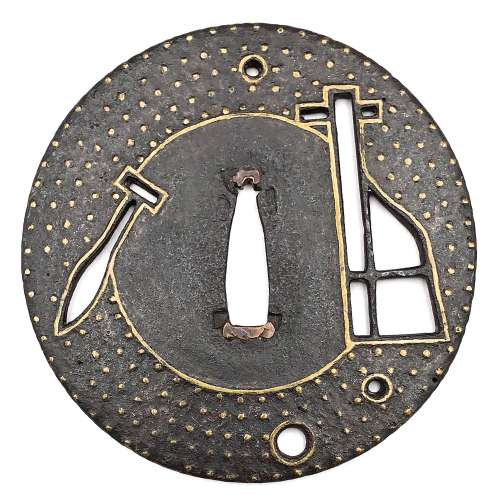 Iron tsuba of round form with design of rudder, paddle, and stars in small openwork (ko-sukshi) outlined with brass wire, and further decorated with inlay of five concentric rows of brass dots or nail heads (ten-zōgan) and circular brass wire inlaid inside the innermost row of dots. Two lower round openings may also serve as udenuki-ana. Copper sekigane. Unsigned. Late Muromachi or Momoyama period, 16th century. Diameter: 90.4 x 89.8 x 2.8 mm.
Iron tsuba of round form with design of rudder, paddle, and stars in small openwork (ko-sukshi) outlined with brass wire, and further decorated with inlay of five concentric rows of brass dots or nail heads (ten-zōgan) and circular brass wire inlaid inside the innermost row of dots. Two lower round openings may also serve as udenuki-ana. Copper sekigane. Unsigned. Late Muromachi or Momoyama period, 16th century. Diameter: 90.4 x 89.8 x 2.8 mm. -
 Artist: Utagawa Toyokuni I [歌川豊国] (1769–1825). Title: 「しなのやおこん 瀬川菊之丞」「帯屋長右衛門 嵐雛助」 Kabuki play: Katsuragawa Renri no Shigarami [桂川連理柵]. According to Waseda University Cultural Resource Database, the play was performed at Ichimura-za (Edo) on the 2nd month of Kansei 12 (year 1800) under the title 楼門五山桐 さんもんごさんのきり. Publisher: Nishimuraya Yohachi [西村屋与八] (Japanese, c. 1751 – 1869)., Play by Suga Sensuke [菅専助] (ca. 1728 – 1791) in two acts. First performed at Kita Horie-za in Osaka in October 1776. Based on a real incident occurring sometime in the Kyōhō era (1716-35), this story was first dramatized in 1761. The first Kabuki drama to stem from this play was in 1777 at Osaka's Araki-za. Obiya Chōemon, a married obi merchant (sitting with abacus) in his forties, meets his neighbour's daughter Ohan (standing behind Obiya), who is young enough to be his daughter, at an inn in Ishibe; the two fall in love and pledged their troth. Ohan becomes pregnant. After a series of misfortunes, the lovers rush to Katsuragawa (Katsura River), where they drown themselves.
Artist: Utagawa Toyokuni I [歌川豊国] (1769–1825). Title: 「しなのやおこん 瀬川菊之丞」「帯屋長右衛門 嵐雛助」 Kabuki play: Katsuragawa Renri no Shigarami [桂川連理柵]. According to Waseda University Cultural Resource Database, the play was performed at Ichimura-za (Edo) on the 2nd month of Kansei 12 (year 1800) under the title 楼門五山桐 さんもんごさんのきり. Publisher: Nishimuraya Yohachi [西村屋与八] (Japanese, c. 1751 – 1869)., Play by Suga Sensuke [菅専助] (ca. 1728 – 1791) in two acts. First performed at Kita Horie-za in Osaka in October 1776. Based on a real incident occurring sometime in the Kyōhō era (1716-35), this story was first dramatized in 1761. The first Kabuki drama to stem from this play was in 1777 at Osaka's Araki-za. Obiya Chōemon, a married obi merchant (sitting with abacus) in his forties, meets his neighbour's daughter Ohan (standing behind Obiya), who is young enough to be his daughter, at an inn in Ishibe; the two fall in love and pledged their troth. Ohan becomes pregnant. After a series of misfortunes, the lovers rush to Katsuragawa (Katsura River), where they drown themselves.Segawa Kikunojō III (Japanese, 1751 – 1810); other names: Segawa Senjo, Segawa Rokō III, Segawa Tomisaburō I, Ichiyama Tomisaburō, Ichiyama Shichinosuke. The actor held the name of Segawa Kikunojō III from the 11th lunar month of 1774 to the 7th lunar month of 1801. He surpassed all the actors of his time in both female and male roles, especially in the former, and achieved tremendous public acclaim.
Arashi Hinasuke II [嵐雛助] (Japanese, c. 1774 – 1801); other names: Nakamura Jūzō III, Kanō Hidenosuke I, Arashi Hidenosuke I. The actor held the name of Arashi Hinasuke II from the 1st lunar month of 1794 to the 2nd lunar month of 1801. Hi died in Edo on the 4th day of the 2nd lunar month of 1801. For the same characters illustrated by Utagawa Kuniyoshi see SVJP-0333.2021. Sources:
Sources:
- Historical Dictionary of Japanese Traditional Theatre By Samuel L. Leiter. Second edition, 2014.
- Kabuki Encyclopedia. An English-Langauge Adaptation of Kabuki Jiten. Samuel L. Leiter. Greenwood Press, 1979.
- http://www.kabuki21.com/
- Waseda University Cultural Resource Database
-
 Artist: Utagawa Kunisada [歌川 国貞] a.k.a. Utagawa Toyokuni III [三代歌川豊国] (Japanese, 1786 – 1865). Block cutter: Horikō (Kiyomizu) Ryūzō [彫工 柳三]. Publisher: Ebisuya Shoshichi [恵比寿屋庄七], Kinshōdō (Japanese, fl. c. 1846 – 1883). Actor Morita Kan'ya XI as Saito Tarozaemon Toshiyuki (Morito Kan'ya, Saito Tarozaemon Toshiyuki) Signed Toyokuni ga within the artist's Toshidama cartouche, publisher's seal Sho, Kinshodo, carver's seal Horiko Ryusan, censor's seal aratame with date 1860, 3rd month. Date: 3/1860. Oban tate-e; 36.5 x 25.3 cm. The actor Morita Kan'ya XI (1802-1863) is in the role of Saito Tarozaemon Toshiyuki from the play Oto no Miya Asahi no Yoroi (Oto no Miyo and the Armor of the Rising Sun). The play picks up following the Genko War of 1331-33 in which Emperor Go-Daigo (1288-1339) led a failed uprising against the ruling Hojo clan. Tarozaemon was a Hojo warlord and is credited with much of the victory. After the conflict, his lord Norisada receives a summer festival lantern from the courtesan Sanmi-no-Tsubone, which bears a riddling inscription. He and Tarozaemon deliberate over the courtesan and her message for quite some time until they realize that she is attempting to manipulate Norisada in the hopes of returning the Emperor from exile. Following this revelation, Norisada reinterprets the message to mean kiriko, literally "to cut a child," and determines that Sanmi-no-Tsubone's son must be killed. He instructs Tarozaemon to do the deed. However, unbeknownst to Norisada and in spite of his allegiance to the Hojo clan, Tarozaemon is sympathetic to Sanmi-no-Tsubone and her son. At one time, his own daughter had served in the Imperial Palace and was spared execution only through Sanmi-no-Tsubone's intervention. As repayment of that debt, he kills his own grandson in the other boy's stead and returns to Norisada to report that he had accomplished the mission. This print is from a series of portraits that Kunisada undertook very late in life and has been named Kinshodo-ban yakusha okubi-e (Kinshodo's Large-Head Actor Portraits) in reference to the publisher, Ebisuya Shochochi of Kinshodo. The series depicted great actors from the past and present in their famous roles. Kunisada was guided by images from his own oeuvre: he recorded Kan'ya in this role in the 8th month of 1829. As this was meant to be Kunisada's grandest actor series, it was executed on thick paper with the best possible pigments and the highest level of craftsmanship. In this unusual frontal portrait, Kunisada presents Morita Kan'ya XI as the loyal Tarozaemon with his eyes rolling upward and his jaw set in grim determination to commit the unthinkable act in an ultimate display of samurai honour. Text by Scholten Japanese Art, New York. Ref.: Waseda University Theatre Museum (enpaku.waseda.ac.jp), accession no. 100-5261 (for 1829 portrait of the same); [LIB-1212.2017] Robert Schaap. Kunisada: Imaging, drama and beauty. — Leiden: Hotei Publishing, 2016, p. 165 (№ 16). Andreas Marks. Publishers of Japanese woodblock prints: A compendium. Ebisuya Shoshichi (1846-83) - P6032.
Artist: Utagawa Kunisada [歌川 国貞] a.k.a. Utagawa Toyokuni III [三代歌川豊国] (Japanese, 1786 – 1865). Block cutter: Horikō (Kiyomizu) Ryūzō [彫工 柳三]. Publisher: Ebisuya Shoshichi [恵比寿屋庄七], Kinshōdō (Japanese, fl. c. 1846 – 1883). Actor Morita Kan'ya XI as Saito Tarozaemon Toshiyuki (Morito Kan'ya, Saito Tarozaemon Toshiyuki) Signed Toyokuni ga within the artist's Toshidama cartouche, publisher's seal Sho, Kinshodo, carver's seal Horiko Ryusan, censor's seal aratame with date 1860, 3rd month. Date: 3/1860. Oban tate-e; 36.5 x 25.3 cm. The actor Morita Kan'ya XI (1802-1863) is in the role of Saito Tarozaemon Toshiyuki from the play Oto no Miya Asahi no Yoroi (Oto no Miyo and the Armor of the Rising Sun). The play picks up following the Genko War of 1331-33 in which Emperor Go-Daigo (1288-1339) led a failed uprising against the ruling Hojo clan. Tarozaemon was a Hojo warlord and is credited with much of the victory. After the conflict, his lord Norisada receives a summer festival lantern from the courtesan Sanmi-no-Tsubone, which bears a riddling inscription. He and Tarozaemon deliberate over the courtesan and her message for quite some time until they realize that she is attempting to manipulate Norisada in the hopes of returning the Emperor from exile. Following this revelation, Norisada reinterprets the message to mean kiriko, literally "to cut a child," and determines that Sanmi-no-Tsubone's son must be killed. He instructs Tarozaemon to do the deed. However, unbeknownst to Norisada and in spite of his allegiance to the Hojo clan, Tarozaemon is sympathetic to Sanmi-no-Tsubone and her son. At one time, his own daughter had served in the Imperial Palace and was spared execution only through Sanmi-no-Tsubone's intervention. As repayment of that debt, he kills his own grandson in the other boy's stead and returns to Norisada to report that he had accomplished the mission. This print is from a series of portraits that Kunisada undertook very late in life and has been named Kinshodo-ban yakusha okubi-e (Kinshodo's Large-Head Actor Portraits) in reference to the publisher, Ebisuya Shochochi of Kinshodo. The series depicted great actors from the past and present in their famous roles. Kunisada was guided by images from his own oeuvre: he recorded Kan'ya in this role in the 8th month of 1829. As this was meant to be Kunisada's grandest actor series, it was executed on thick paper with the best possible pigments and the highest level of craftsmanship. In this unusual frontal portrait, Kunisada presents Morita Kan'ya XI as the loyal Tarozaemon with his eyes rolling upward and his jaw set in grim determination to commit the unthinkable act in an ultimate display of samurai honour. Text by Scholten Japanese Art, New York. Ref.: Waseda University Theatre Museum (enpaku.waseda.ac.jp), accession no. 100-5261 (for 1829 portrait of the same); [LIB-1212.2017] Robert Schaap. Kunisada: Imaging, drama and beauty. — Leiden: Hotei Publishing, 2016, p. 165 (№ 16). Andreas Marks. Publishers of Japanese woodblock prints: A compendium. Ebisuya Shoshichi (1846-83) - P6032. -
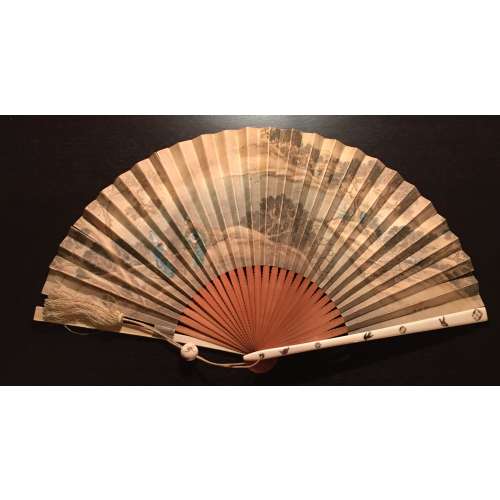 Late 19th-century (1850-1870) Japanese export fan. This fan has a double leaf painted with a different design on either side. Ivory encrusted with gemstones (birds and shippomon motif). Painting by ukiyo-e artist and printmaker Katsushika Isai (1821–1880) represents a riverside landscape with figures; birds and flowers on the reverse. Signed: Isai ga (為斎画) - "Painted by Isai".
Late 19th-century (1850-1870) Japanese export fan. This fan has a double leaf painted with a different design on either side. Ivory encrusted with gemstones (birds and shippomon motif). Painting by ukiyo-e artist and printmaker Katsushika Isai (1821–1880) represents a riverside landscape with figures; birds and flowers on the reverse. Signed: Isai ga (為斎画) - "Painted by Isai". -
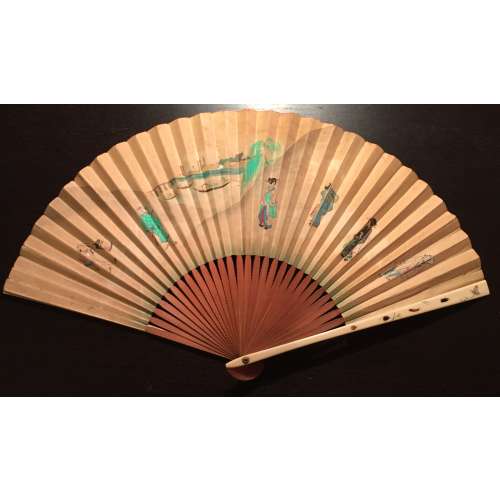 Late 19th-century (1850-1870) Japanese export fan. This fan has a double leaf painted with a different design on either side. Ivory encrusted with gemstones and other materials. Subject matter such as women wearing kimono is also more typical of export than domestic products (V&A). Summer (birds and flowers) theme on the reverse.
Late 19th-century (1850-1870) Japanese export fan. This fan has a double leaf painted with a different design on either side. Ivory encrusted with gemstones and other materials. Subject matter such as women wearing kimono is also more typical of export than domestic products (V&A). Summer (birds and flowers) theme on the reverse. -
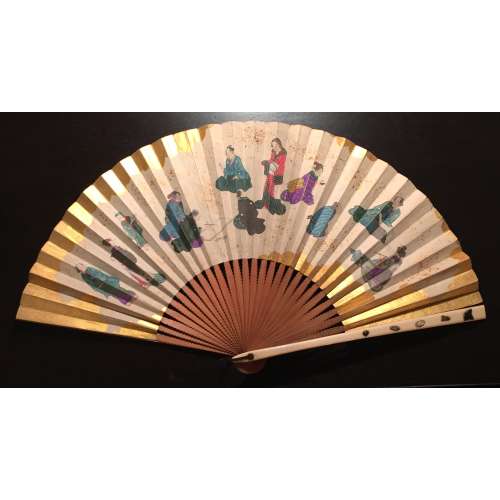 Late 19th-century (1850-1870) Japanese export fan. This fan has a double leaf painted with a different design on either side. Ivory encrusted with gemstones and other materials. Subject matter such as women wearing kimono is also more typical of export than domestic products (V&A). Autumn theme on the reverse.
Late 19th-century (1850-1870) Japanese export fan. This fan has a double leaf painted with a different design on either side. Ivory encrusted with gemstones and other materials. Subject matter such as women wearing kimono is also more typical of export than domestic products (V&A). Autumn theme on the reverse. -
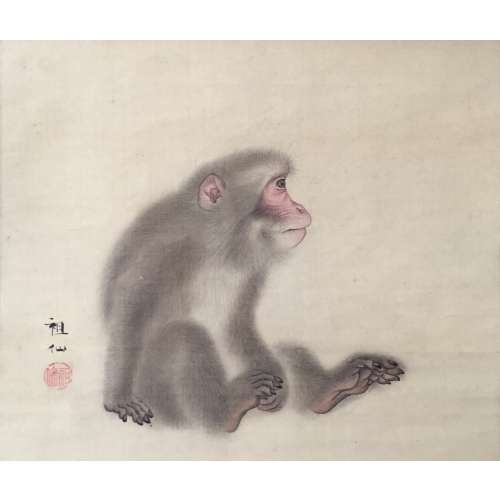 Mori Sosen (1747-1821). Seated Monkey. Hanging scroll painting. Ink and colour on silk. Signed: Sosen. Sealed: Sosen. 28.8 x 33.3 cm.
Mori Sosen (1747-1821). Seated Monkey. Hanging scroll painting. Ink and colour on silk. Signed: Sosen. Sealed: Sosen. 28.8 x 33.3 cm. -
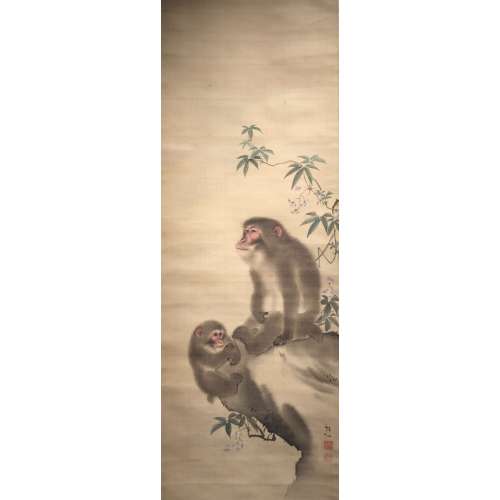 Mori Sosen (1747-1821). A Monkey Seated on a Rock with an Infant Monkey. Hanging scroll painting. Ink and colour on silk. Signed: Sosen. Sealed: Sosen. 108.3 x 38.3 cm. Provenance: According to the box inscriptions, the painting was in the possession of Itakura Katsunao, a daimyo lord in present-day Gunma, in 1808. In 1881, the painting was subsequently acquired by Negishi Shôrei (1833-1897) a master swordsman who established the Negishi school of shuriken ("The only specialist school to have survived is the Negishi-ryū, which was founded by Negishi Shorei in the mid-1800s".)
Mori Sosen (1747-1821). A Monkey Seated on a Rock with an Infant Monkey. Hanging scroll painting. Ink and colour on silk. Signed: Sosen. Sealed: Sosen. 108.3 x 38.3 cm. Provenance: According to the box inscriptions, the painting was in the possession of Itakura Katsunao, a daimyo lord in present-day Gunma, in 1808. In 1881, the painting was subsequently acquired by Negishi Shôrei (1833-1897) a master swordsman who established the Negishi school of shuriken ("The only specialist school to have survived is the Negishi-ryū, which was founded by Negishi Shorei in the mid-1800s".) -
 Utagawa Toyokuni (歌川豐國); 1769 – 24 February 1825. The actor Nakamura Utaemon as Ishikawa Goemon. Circa 1810. Size/Format: Oban, 9.75 by 14.5 inches
Utagawa Toyokuni (歌川豐國); 1769 – 24 February 1825. The actor Nakamura Utaemon as Ishikawa Goemon. Circa 1810. Size/Format: Oban, 9.75 by 14.5 inches -
 Katsukawa Shunshō ( 勝川 春章; 1726 – 19 January 1793).
Katsukawa Shunshō ( 勝川 春章; 1726 – 19 January 1793).SIZE: 12.5 x 5.75 in.
-
 Kitagawa Utamaro (喜多川 歌麿; c. 1753 – 31 October 1806). Act III (Sandanme), from the series The Storehouse of Loyal Retainers (Chûshingura). Publisher Nishimuraya Yohachi (Eijudô). About 1801–02 (Kyôwa 1–2) Vertical ôban; 39.3 x 26 cm (15 1/2 x 10 1/4 in.). Reference: MFA ACCESSION NUMBER 11.14441 Ukiyo-e shûka 3 (1978), list #368.3; Shibui, Ukiyo-e zuten Utamaro (1964), 165.1.3; the series: Asano and Clark 1995, #s 383-5.
Kitagawa Utamaro (喜多川 歌麿; c. 1753 – 31 October 1806). Act III (Sandanme), from the series The Storehouse of Loyal Retainers (Chûshingura). Publisher Nishimuraya Yohachi (Eijudô). About 1801–02 (Kyôwa 1–2) Vertical ôban; 39.3 x 26 cm (15 1/2 x 10 1/4 in.). Reference: MFA ACCESSION NUMBER 11.14441 Ukiyo-e shûka 3 (1978), list #368.3; Shibui, Ukiyo-e zuten Utamaro (1964), 165.1.3; the series: Asano and Clark 1995, #s 383-5. -
 Utagawa Toyokuni (歌川豐國); 1769 – 24 February 1825. The kabuki actors Ichikawa Danzo IV as Jiroemon (in draw cape) and Morita Kanya VIII as Buemon. Play 'Oriai Tsuzure no Nishiki', performed at the Moritaza Theater in the 7th month of 1798. Publisher: Eijudo.
Utagawa Toyokuni (歌川豐國); 1769 – 24 February 1825. The kabuki actors Ichikawa Danzo IV as Jiroemon (in draw cape) and Morita Kanya VIII as Buemon. Play 'Oriai Tsuzure no Nishiki', performed at the Moritaza Theater in the 7th month of 1798. Publisher: Eijudo. -
 Bando Mitsugorō III as Lady Iwafuji and Nakamura Matsue III as Lady Onoe, 1821.「局岩ふじ 坂東三津五郎」(三代)、「中老尾上 中村松江」(三代) in kabuki play Kagamiyama Kokyô no Nishikie [鏡山旧錦繪] (Mirror mountain: A women’s treasury of loyalty); author: Yô Yôdai. Artist: Shunkōsai Hokushū (春好斎 北洲), who is also known as Shunkō IV, active from about 1802 to 1832. Actors: Bandō Mitsugorō III [三代目 坂東 三津五郎] (Japanese, 1775 – 1831); other names: Bandō Minosuke I, Morita Kanjirô II, Bandō Mitahachi I, Bandō Minosuke I, Bandō Mitahachi I. Nakamura Matsue III [三代目中村松江] (Japanese, 1786-1855); other names: Nakamura Sankō I, Nakamura Tomijūrō II, Ichikawa Kumatarō. Year: 1821 (Bunsei 4), 1st month. Publisher: Wataya Kihei (Wataki) (Japanese, fl. c. 1809 – 1885) Signed Shunkôsai Hokushû ga 春好斎北洲画. MFA Accession № 11.35375. MFA description: "Play: Keisei Kagamiyama (Mirror Mountain, a Courtesan Play). Theatre: Kado けいせい双鏡山(けいせいかがみやま)角. Ref.: [LIB-1193.2013] Leiter. Kabuki Encyclopedia, p. 156; [LIB-0879-2.2015] Kabuki plays on stage (vol. 2): 1773-1799, pp. 172-212.
Bando Mitsugorō III as Lady Iwafuji and Nakamura Matsue III as Lady Onoe, 1821.「局岩ふじ 坂東三津五郎」(三代)、「中老尾上 中村松江」(三代) in kabuki play Kagamiyama Kokyô no Nishikie [鏡山旧錦繪] (Mirror mountain: A women’s treasury of loyalty); author: Yô Yôdai. Artist: Shunkōsai Hokushū (春好斎 北洲), who is also known as Shunkō IV, active from about 1802 to 1832. Actors: Bandō Mitsugorō III [三代目 坂東 三津五郎] (Japanese, 1775 – 1831); other names: Bandō Minosuke I, Morita Kanjirô II, Bandō Mitahachi I, Bandō Minosuke I, Bandō Mitahachi I. Nakamura Matsue III [三代目中村松江] (Japanese, 1786-1855); other names: Nakamura Sankō I, Nakamura Tomijūrō II, Ichikawa Kumatarō. Year: 1821 (Bunsei 4), 1st month. Publisher: Wataya Kihei (Wataki) (Japanese, fl. c. 1809 – 1885) Signed Shunkôsai Hokushû ga 春好斎北洲画. MFA Accession № 11.35375. MFA description: "Play: Keisei Kagamiyama (Mirror Mountain, a Courtesan Play). Theatre: Kado けいせい双鏡山(けいせいかがみやま)角. Ref.: [LIB-1193.2013] Leiter. Kabuki Encyclopedia, p. 156; [LIB-0879-2.2015] Kabuki plays on stage (vol. 2): 1773-1799, pp. 172-212.


